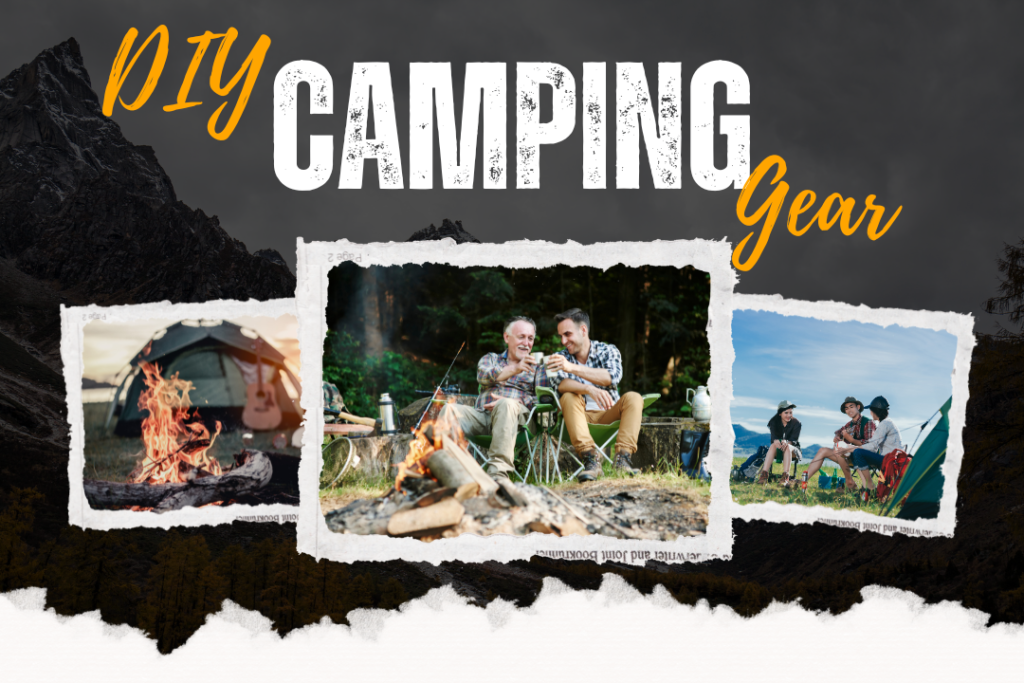Camping offers a way to escape from the hustle of daily life and immerse oneself in the tranquility of nature. But what if you could take that adventure a step further by crafting your own camping gear? DIY camping gear has seen a surge in popularity, appealing to campers looking for a more personalized, cost-effective, and sustainable way to explore the outdoors.
In this guide, we’ll dive deep into various DIY camping gear projects—from making your own sleeping bags to crafting portable cooking equipment. You’ll discover how to tailor each piece to your unique needs and preferences, ensuring that every camping trip is customized for your adventure style.
DIY Camping Gear
The Rise of DIY Camping Gear Culture
In recent years, there’s been a growing movement towards DIY (Do-It-Yourself) solutions in the outdoor community. Campers are not only looking for ways to save money but also seeking more personal connections with their gear. By making your own equipment, you have full control over design, materials, and functionality. The result? A unique piece of equipment that reflects your outdoor style.
Benefits of Crafting Your Own Equipment
When you make your own camping gear, you open up a world of possibilities. One of the key advantages is customization. Store-bought equipment is often designed to suit the average camper, but by crafting your own, you can adapt designs to your specific needs, whether it’s added comfort, extra pockets, or lightweight materials for long hikes.
DIY camping gear also tends to be more sustainable. You can repurpose old materials, use natural resources, and avoid the mass-produced gear that often involves harmful manufacturing practices. Additionally, it’s a fun and rewarding process that helps develop practical skills.
Cost-Effective and Sustainable Camping Gear
Store-bought camping equipment, especially high-quality gear, can be expensive. By crafting your own, you can significantly cut costs without compromising on functionality. Many DIY projects allow you to repurpose materials you already have at home, reducing waste and promoting sustainability. For example, turning an old down jacket into a sleeping bag or using recycled materials for water filters cuts down on both cost and environmental impact.
Essential Tools for DIY Camping Gear Projects
Basic Tools Needed for Making Camping Equipment
Before starting any DIY camping project, you’ll need a few basic tools. A quality sewing kit, strong scissors, measuring tape, and heavy-duty needles are essential for most fabric-based projects like sleeping bags and backpacks. Additionally, a utility knife, duct tape, and a hot glue gun can come in handy for quick fixes and assembling more complex equipment.
Advanced Tools for More Complex Projects
For more elaborate DIY projects, such as building a camping stove or crafting a durable backpack, you’ll need more advanced tools like a rivet gun, pliers, and even basic welding equipment if you’re working with metals. These tools allow you to create durable, professional-grade gear that can withstand tough outdoor conditions.
Safety Considerations When Working with Tools
While crafting your own camping gear is a fun and creative process, safety should always come first. Ensure you’re working in a well-lit, organized space and always wear protective gear such as gloves and safety glasses when working with sharp or hot tools. Take your time to avoid accidents, especially when working with potentially hazardous materials like fuel for DIY stoves.
DIY Sleeping Gear: Sleeping Bags and Pads
How to Make a DIY Sleeping Bag
Crafting your own sleeping bag is a rewarding project that ensures warmth and comfort during your outdoor trips. Start by choosing insulating materials such as down or synthetic fibers, which you can repurpose from old jackets or blankets. A sleeping bag shell can be sewn from ripstop nylon, which is both lightweight and durable. The key to a successful sleeping bag is careful stitching to prevent cold air from seeping in through seams.
Crafting Your Own Sleeping Pad for Comfort
Sleeping on the ground can be uncomfortable, which is why a good sleeping pad is essential for a restful night in the wilderness. For a DIY pad, you can use materials like foam or inflatable plastic. Cutting foam to size and layering it with a reflective material can help retain body heat. For a more advanced project, you could create an inflatable sleeping pad by sealing heat-resistant plastic with a vacuum sealer and adding a valve for inflation.
Pros and Cons of Homemade Sleeping Gear
While DIY sleeping gear offers customization and cost savings, it may not always match the insulation and compactness of commercial gear. However, by carefully selecting high-quality materials and refining your techniques, homemade gear can rival store-bought options. The biggest advantage of DIY sleeping gear is the ability to create a custom fit and comfort level tailored specifically to your needs.
Continue through each heading in the outline, providing detailed instructions, insights, and explanations. The article should maintain a balance of practical advice, step-by-step tutorials, and general tips for personalizing DIY camping gear.
FAQs
Is DIY camping gear safe?
Yes, as long as you follow proper guidelines for selecting materials and constructing gear. Test each piece thoroughly before heading into the wilderness.
How much money can I save with DIY camping gear?
DIY gear can save you hundreds of dollars compared to commercial options, especially for big-ticket items like tents, sleeping bags, and backpacks.
Can I make camping gear with no prior experience?
Yes! Many DIY camping projects are beginner-friendly. Start with simple projects like making fire starters or a basic tarp shelter before progressing to more complex tasks.
What are the best materials for beginners?
Durable fabrics like ripstop nylon, synthetic insulation, and foam are great starting materials for beginners. These are easy to work with and widely available.
How do I ensure my DIY gear is weather-resistant?
Use waterproof coatings, seal seams carefully, and choose weatherproof materials to ensure your DIY gear can withstand rain and wind.
Are there any online communities or resources for DIY camping gear?
Yes, there are many online forums, blogs, and YouTube channels dedicated to DIY camping gear. These resources offer tutorials, advice, and inspiration from experienced DIY enthusiasts.


